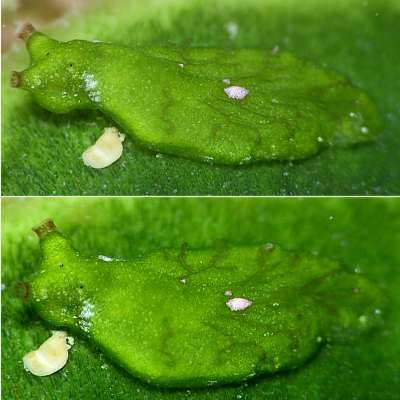
Bosellia sp. 1
Order: SACOGLOSSA
Superfamily: ELYSIOIDEA
Family: Elysiidae
DISTRIBUTION
Sthn Japan, Hawaii
PHOTO
Amami Ooshima Islands, Kagoshima, Japan. Length: approx 6mm. Depth: 2 m. 7 Jan 2004. Photos: Jun Imamoto
There are passing references in the literature to Bosellia being found in the Red Sea and Hawaii. Atsushi Ono also includes photos of this species in his book Opisthobranchs of Kerama Islands, from sthn Japan. It is not possible to say whether it a species endemic to the region or a species artificially introduced from the Atlantic.
Authorship detailsRudman, W.B., 2004 (February 29) Bosellia sp. 1 [In] Sea Slug Forum. Australian Museum, Sydney. Available from http://www.seaslugforum.net/find/bosesp1
Related messages
First Bosellia from Australia
August 15, 2006
From: Denis Riek
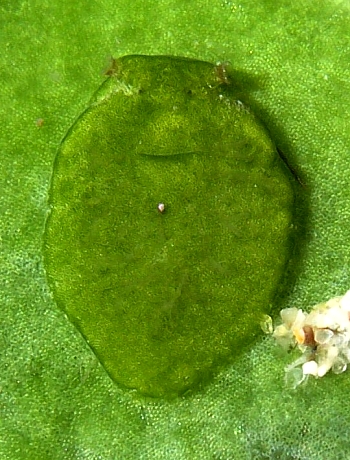
Dear Bill,
Here are some shots of Bosellia sp. 1? from northern New South Wales. It was found on Halimeda weed just below low tide mark on rock reef. At 6 mm this is the largest animal I have found, previous ones were very small and nearly overlooked due to their resemblance to flatworms. It has a white spot and shallow grooves on the dorsum as in the animal shown in Jun Imamoto's message. It also has what appears to be some form of discharge(?) over the dorsum. Any ideas as to what this is?
Locality: Hastings Point, northern New South Wales, 1 metre, Australia, Pacific, 17 December 2005, On Halimeda, subtidal rock reef. Length: 6 mm. Photographer: Denis Riek.
Regards
Denis
dwriek@optusnet.com
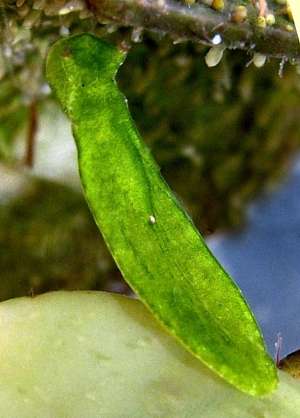
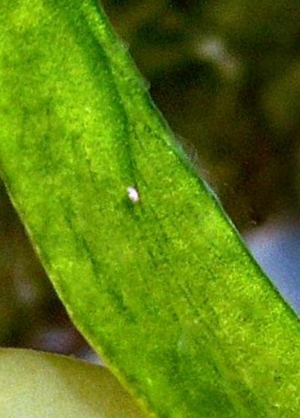
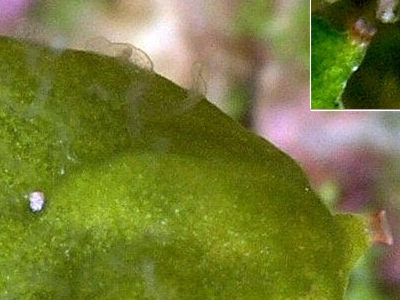
Dear Denis,
This is indeed an interesting find. It is the first record of the genus from Australia, or anywhere in the south Pacific, and certainly looks the same as the animal from Japan and Hawaii which are on the Forum as Bosellia sp. 1. Two quite distinctive features seem to be the white (sometimes pinkish) spot in the middle of the back, and the strangely shaped rhinophores, with the rounded green basal half and the upper, thin, almost translucent, brownish. Looking at your photos, the brown colouration stops below the tip of the rhinophore giving it a translucent margin, which in some cases seems to have whitish glands forming a band. In a couple of photos [see inset alongside] there are also traces of a whitish band at the base of the upper thin half of the rhinophore as well.
Looking at the colour of the rhinophore in this detail may seem a bit fanatical, but Eveline Marcus (1978) described a species, Bosellia cohellia, and its only real distinguishing feature is the rhinophore colour:
'they have pinkish tips and two broad chalk white bands, the three interrupted by two stripes of the green ground colour' .
I am afraid this is another species description which should probably have been left unpublished. It was based on one photographic colour slide, and serial sections of one specimen sent to her by Tom Thompson, who was not sure if the specimen was from the Mediterranean or the Red Sea! When I look at other photos of Bosellia sp. 1, it is not unreasonable to fit her colour description of the rhinophores to some of these specimens. I guess what we need to do now is hope that someone will look carefully at Halimeda in the Red Sea and see if this animal can be found there.
Concerning the 'discharge' you mentioned. I have included a couple of close-ups from your photos you show there is a secretion being given off by the skin. Most sacoglossans produce mucous secretions from glands in their skin, which are presumed to be defensive. They are often milky white. I guess that is what we can see here. Another thing that would be interesting to find out is what its egg mass looks like. In shape it should probably look like that of Thuridilla neona [message # 9719 ], but not necessarily that colour. It will probably have large blobs of extra yolk as in Thuridilla, and I would expect the eggs to be deposited on Halimeda.
-
Marcus, Ev. (1978) On a new species of Bosellia. Boletim de Zoologia da Universidade de Sao Paulo, 3: 1-6.
Best wishes,
Bill Rudman
Bosellia sp. 1 from Okinawa
March 5, 2004
From: Bob Bolland
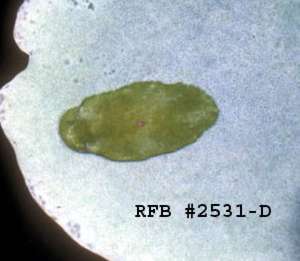
Hi Bill,
Continuing with the earlier Bosellia sp. 1 thread, here's an additional animal from Okinawa. Two animals (7mm & 9mm) were found on the same Halimeda colony, along with what appeared to be two Elysiella pusilla. Specimens deposited with Terry at CAS.
Data:
RFB: #2531-D. TL: 7mm.
From 5ft of water on Halimeda.
Horseshoe Cliffs (Onna), Okinawa, 6 May 1991
Cheers,
Bob
bollandr@rapid-link.ne.jp
Bolland, R.F., 2004 (Mar 5) Bosellia sp. 1 from Okinawa. [Message in] Sea Slug Forum. Australian Museum, Sydney. Available from http://www.seaslugforum.net/find/12372Thanks Bob,
This species seems to have a borad distribution from Hawaii across to sthn Japan. It will be interesting to see if it turns up elsewhere in the tropical Pacific
In your animal, like the one in Jun Imamoto's second message [#12349], the central spot is pink rather than white
Best wishes
Bill Rudman
Re: Bosellia mimetica? from Japan.
March 3, 2004
From: Jun Imamoto
Dear Bill,
Concerning the algae identification [#12349] - it is not Chlorodesmis caespitosa, but rather Udotea orientalis. I had advice on this from Atsushi Ono as well.
I think the individual in the second photo is another seaweed. The slug must have moved there while I was photographing.
Best Regards,
Jun Imamoto
imamoto@umiushi.info
Imamoto, J., 2004 (Mar 3) Re: Bosellia mimetica? from Japan.. [Message in] Sea Slug Forum. Australian Museum, Sydney. Available from http://www.seaslugforum.net/find/12360Thanks Jun,
Bosellia is known from Udotea so that makes mmore sense
Best wishes
Bill Rudman
Re: Bosellia from Japan
March 2, 2004
From: Cory Pittman
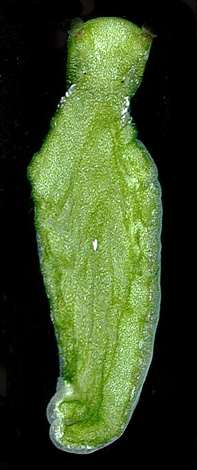
Dear Bill,
Concerning your comments on Jun Imamoto's recent message [#11858]:
I'm probably the source of the Hawaiian animal in the photo that Terry showed to Kathe. So, I thought I'd send a bit of info. :-)
In 1999, I found five specimens in shallow Maui waters. The first four were collected between April 19 and April 26 at Hekili Point. They were taken in algae washes at depths of around 1 m in a semi-protected, back reef habitat. The fifth was collected on November 11 in an algae wash that covered a depth range of 0.5 to 2.6 m on an accretion platform at Maalaea Bay. Sizes ranged between 3.5 mm and 7 mm. All animals were bright green with variable amounts of white mottling and a hint of dusky-pink on the translucent tips of their rhinophores. A small amount of dusky-pink was sometimes present on the anterior edges of their parapodia.
The 7 mm animal, collected on April 26, was held for several days in a small dish with a piece of Halimeda discoidea (a common species in the habitats where they were found). I observed it feeding on the Halimeda and it showed a diurnal activity pattern. While held, it laid three egg masses: on April 29th (12 whorls, 2.5 mm in diameter); on May 2nd (10 whorls, 2.3 mm in diameter); on May 5 (8 whorls, 2 mm in diameter). All of the egg masses were circular and composed of a tightly coiled ribbon only one or two eggs in thickness. The eggs were bright lemon-yellow and there was an interrupted line of opaque lemon-yellow “extra-capsular yolk” running along the inner margin of the ribbon. The interruptions in the line of “extra-capsular yolk” were very regular giving it the appearance of a row of short dashes.
Unfortunately, I didn't photograph the egg masses (that was before I'd purchased my digital camera). However, I gave Pauline Fiene one of the animals to photograph. The attached shot of it crawling was taken by her. The specimens were deposited with Terry at CAS.
By the way, Atsushi Ono also includes photos of this species in his book Opisthobranchs of Kerama Islands (misspelled as "cf. Besellia mimetica").
I hope this will be of interest.
Best wishes,
Cory Pittman
cory@cet.com
Pittman, C., 2004 (Mar 2) Re: Bosellia from Japan. [Message in] Sea Slug Forum. Australian Museum, Sydney. Available from http://www.seaslugforum.net/find/12348Thanks Cory,
I don't know if the white mark in the middle of the back is significant but both your animal and the Japanese ones have it. When Eveline Marcus was working on these animals she encouraged me to go looking for them in the Indo-Pacific on Halimeda. Although I have found plenty of Elysiella pusilla, I am still to find a Bosellia. They are clearly very well camouflaged.
Best wishes
Bill Rudman
Re: Bosellia mimetica? from Japan.
March 2, 2004
From: Jun Imamoto
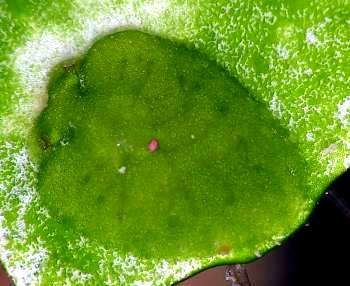
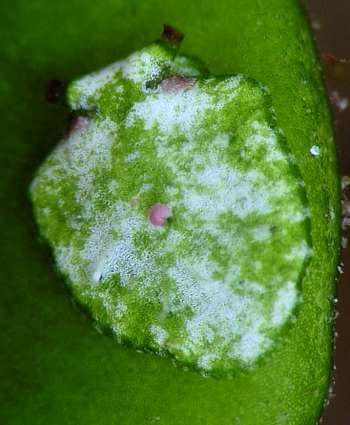
Note added 3 March 2004: Jun Imamoto has reindentified the algae as Udotea orientalis, and suggested the algae in this photo is not the slug's food [see message #12360].
Dear Bill and Kathe,
Thank you for your comments [#11858, #12346]
I found four individuals. Here are photos of two animals, one of which has a white spot. They were found on the green algae Chlorodesmis caespitosa. I hope this information is useful.
Amami-Ooshima Islands, Kagoshima, Japan.
size approx: 6mm., Depth: 2 m. Temp: 20 C. 8 February 2004. Photos: Jun Imamoto
Best Regards,
Jun Imamoto
www.umiushi.info/
imamoto@umiushi.info
Imamoto, J., 2004 (Mar 2) Re: Bosellia mimetica? from Japan.. [Message in] Sea Slug Forum. Australian Museum, Sydney. Available from http://www.seaslugforum.net/find/12349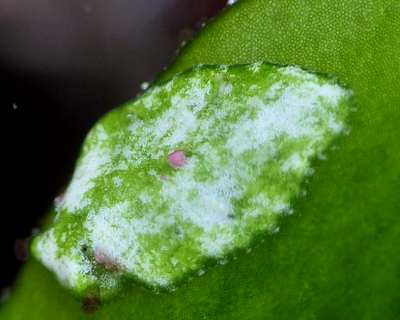
Thanks Jun,
These animals look a bit more mature than the earlier ones,, and the colour pattern with whitish patches looks very much like the whitish patches on the alga. I suspect the white spot turns pink in older individuals.
I am curious about the algae you found these on, because the algae in this photos seems to be different from the one in your earlier message. This one seems to have a surface covered in smooth 'bubbles' while the algae in the earlier message seems to be covered in short filaments. I have attached a message [#12358] with close-ups of the other algae. I am not an expert on algae so I am not sure what Chlorodesmis caespitosa looks like. Why I am so interested is that elsewhere, Bosellia is usually associated with Halimeda.
Best wishes
Bill
Re: Bosellia from Japan
March 2, 2004
From: Bill Rudman
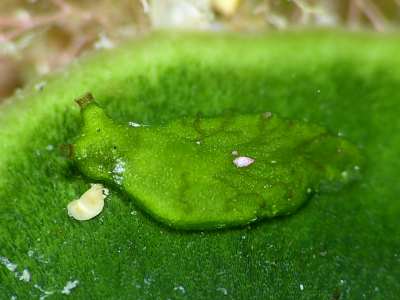
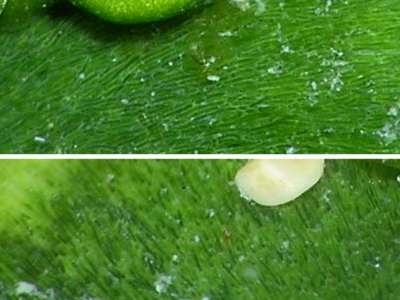
For comparison, here are some close-ups showing the structure of the algae on which Jun Imamoto's first specimens of Bosellia sp. 1 were photographed on [#11858]. It seems a bit different from the algae in the second set of photos #12349.
Best wishes
Bill Rudman
Bosellia mimetica? from Japan.
March 1, 2004
From: Jun Imamoto

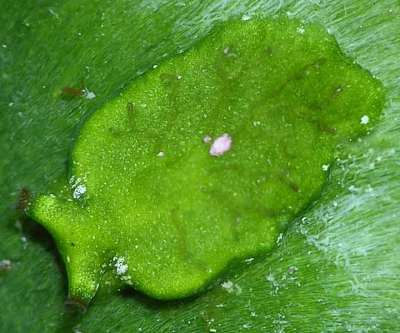
Dear Bill,
This is the first time I have seen this sea.
I think that it looks like Bosellia mimetica. Is that possible from the viewpoint of distribution? I would be very happy if I could hear your comment.
7 Jan 2004
place: Amami Ooshima Islands, Kagoshima, Japan.
size about: 6mm
depth: 2 m
temperature: 22 C
Best Regards,
Jun Imamoto
http://www.umiushi.info/
imamoto@umiushi.info
Imamoto, J., 2004 (Mar 1) Bosellia mimetica? from Japan.. [Message in] Sea Slug Forum. Australian Museum, Sydney. Available from http://www.seaslugforum.net/find/11858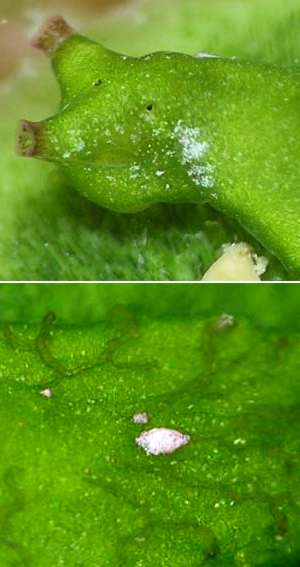
Dear Jun,
This is indeed an interesting find. I have checked with Kathe Jensen [#12346] who agrees that it is a species of Bosellia. There are only 'hints' at Bosellia being found in the Indo-West Pacific. Marcus (1978) mentioned specimens from the Red Sea and Burn(1998) mentions that Sherman Bleakney found specimens in Hawaii. It is interesting that Kathe Jensen mentions a sighting from Hawaii as well, in her message. As she says, until we know more it is difficult to say whether your animal is the same as one of the Atlantic species. If it is, it would be a very unusual 'natural distribution'.
I am interested in how some of the blood vessels appear to form small raised papillae on the animal, almost as though they are proto-cerata or perhaps all that are left of the cerata of some ancestor. I understand that Bosellia doesn't fit perfectly in the Elysioidea. Perhaps its specialised shape and apparent loss of features need to be re-evaluated.
The other interesting feature is the algae your animals are on. I understood that species of Bosellia fed on Halimeda and the related Udotea. Have you a photo of the whole algal plant or do you know what it is? It would be useful to have an identification.
• Burn, 1998 [In} Beesley, P.L., Ross, G.J.B. & Wells, A.(eds), 1998. Mollusca - The Southern Synthesis
• Marcus, Ev. (1978) On a new species of Bosellia. Boletim de Zoologia da Universidade de Sao Paulo, 3: 1-6.
Best wishes
Bill Rudman
Re: Bosellia from Japan
March 1, 2004
From: Kathe Jensen
Dear Bill,
Concerning Jun Imamoto's interesting photos [#11858]. I am sure this is Bosellia. Officially Bosellia is not known from the Pacific, but I remember Terry Gosliner showing me a slide of one - I think from Hawaii. It is difficult to say whether the species in Jun Imamoto's pictures is one of the Atlantic/Caribbean ones that has been transported on a ship or whether it is an undescribed species.
Kathe
KRJensen@zmuc.ku.dk
Jensen, K.R., 2004 (Mar 1) Re: Bosellia from Japan. [Message in] Sea Slug Forum. Australian Museum, Sydney. Available from http://www.seaslugforum.net/find/12346